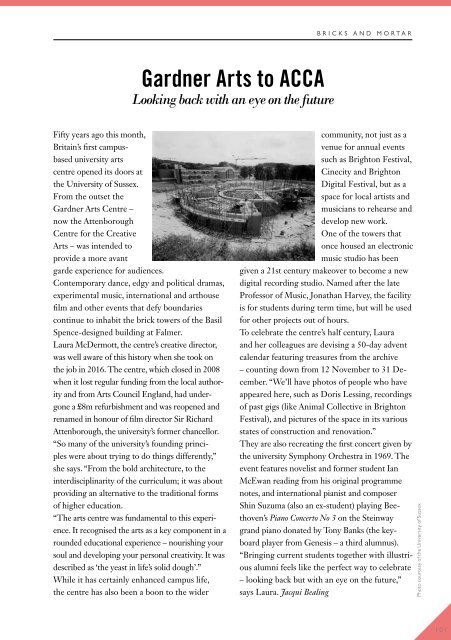You also want an ePaper? Increase the reach of your titles
YUMPU automatically turns print PDFs into web optimized ePapers that Google loves.
BRICKS AND MORTAR<br />
Gardner Arts to ACCA<br />
Looking back with an eye on the future<br />
Fifty years ago this month,<br />
Britain’s first campusbased<br />
university arts<br />
centre opened its doors at<br />
the University of Sussex.<br />
From the outset the<br />
Gardner Arts Centre –<br />
now the Attenborough<br />
Centre for the Creative<br />
Arts – was intended to<br />
provide a more avant<br />
garde experience for audiences.<br />
Contemporary dance, edgy and political dramas,<br />
experimental music, international and arthouse<br />
film and other events that defy boundaries<br />
continue to inhabit the brick towers of the Basil<br />
Spence-designed building at Falmer.<br />
Laura McDermott, the centre’s creative director,<br />
was well aware of this history when she took on<br />
the job in 2016. The centre, which closed in 2008<br />
when it lost regular funding from the local authority<br />
and from Arts Council England, had undergone<br />
a £8m refurbishment and was reopened and<br />
renamed in honour of film director Sir Richard<br />
Attenborough, the university’s former chancellor.<br />
“So many of the university’s founding principles<br />
were about trying to do things differently,”<br />
she says. “From the bold architecture, to the<br />
interdisciplinarity of the curriculum; it was about<br />
providing an alternative to the traditional forms<br />
of higher education.<br />
“The arts centre was fundamental to this experience.<br />
It recognised the arts as a key component in a<br />
rounded educational experience – nourishing your<br />
soul and developing your personal creativity. It was<br />
described as ‘the yeast in life’s solid dough’.”<br />
While it has certainly enhanced campus life,<br />
the centre has also been a boon to the wider<br />
community, not just as a<br />
venue for annual events<br />
such as Brighton Festival,<br />
Cinecity and Brighton<br />
Digital Festival, but as a<br />
space for local artists and<br />
musicians to rehearse and<br />
develop new work.<br />
One of the towers that<br />
once housed an electronic<br />
music studio has been<br />
given a 21st century makeover to become a new<br />
digital recording studio. Named after the late<br />
Professor of Music, Jonathan Harvey, the facility<br />
is for students during term time, but will be used<br />
for other projects out of hours.<br />
To celebrate the centre’s half century, Laura<br />
and her colleagues are devising a 50-day advent<br />
calendar featuring treasures from the archive<br />
– counting down from 12 <strong>November</strong> to 31 December.<br />
“We’ll have photos of people who have<br />
appeared here, such as Doris Lessing, recordings<br />
of past gigs (like Animal Collective in Brighton<br />
Festival), and pictures of the space in its various<br />
states of construction and renovation.”<br />
They are also recreating the first concert given by<br />
the university Symphony Orchestra in 1969. The<br />
event features novelist and former student Ian<br />
McEwan reading from his original programme<br />
notes, and international pianist and composer<br />
Shin Suzuma (also an ex-student) playing Beethoven’s<br />
Piano Concerto No 3 on the Steinway<br />
grand piano donated by Tony Banks (the keyboard<br />
player from Genesis – a third alumnus).<br />
“Bringing current students together with illustrious<br />
alumni feels like the perfect way to celebrate<br />
– looking back but with an eye on the future,”<br />
says Laura. Jacqui Bealing<br />
Photo courtesy of the University of Sussex<br />
101

















